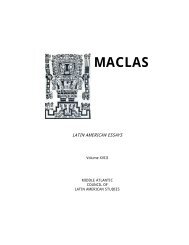latin american essays maclas
latin american essays maclas
latin american essays maclas
Create successful ePaper yourself
Turn your PDF publications into a flip-book with our unique Google optimized e-Paper software.
heterogeneidad cultural. En otras palabras, si Gutiérrez no fractura el discurso<br />
hegemónico, por lo menos nos muestra y realza sus fisuras y fracturas. Gutiérrez<br />
inventa una nueva tradición histórica que se implanta firmemente en la mente<br />
del lector y se incorpora al imaginario histórico nacional.<br />
Para terminar, Chacho, el caudillo gaucho y federal, es hoy, gracias a la<br />
labor del unitario Gutiérrez, entre otros, una figura que materializa la comunidad<br />
imaginada, una de esas figuras que tornan una sociedad visible a sí misma, una<br />
personificación del imaginario nacional argentino. La performatividad del Chacho<br />
se textualiza, y somos testigos de una rebelión popular del interior del país que<br />
fue soterrada, o sea, una perfomatividad ya pasada, vencida y dirimida.<br />
Gutiérrez muy sutilmente da una vuelta de tuerca y articula un discurso<br />
pedagógico que contiene y controla la performatividad pasada del Chacho.<br />
Paradójicamente, la narrativa de Gutiérrez solidifica la nueva tradición histórica<br />
nacional de los vencedores. Por lo tanto, Gutiérrez territorializa el imaginario, o<br />
se apropia de la figura del mítico caudillo riojano, siendo de esta manera más<br />
astuto y maquiavélico que su correligionario Sarmiento, en su simple desprecio<br />
de la “barbarie”, por la cual sentía, “una invencible repugnancia”.<br />
Notas<br />
1 Una versión anterior de este trabajo fue presentada en la conferencia anual de<br />
MACLAS XXVII, que tuvo lugar en Ponce, Puerto Rico, el 13 y 14 de marzo de<br />
2006. Quiero agradecer a mis amigos y colegas, Ana Del Sarto y Abril Trigo por<br />
sus puntuales comentarios, y por su ayuda en el proceso de edición de este<br />
trabajo.<br />
2<br />
De acuerdo al análisis de Shumway, las diferencias ideológicas entre unitarios<br />
y federales pueden sintetizarse de la siguiente manera: “By 1820 the fault line<br />
underlying Argentine society was clearly visible. […] On the one side of the fault<br />
were the liberals, mostly the Unitarians of Buenos Aires, who lived facing Europe,<br />
and were anxious to import the latest, most modern ideas from abroad, to<br />
wrench their embryonic nation into modernity whatever the cost […] On the<br />
other side of the fault were Federalists, provincial caudillos, and populists of<br />
several stripes. Although their dream for Argentina was less clear and less<br />
articulate than that of their liberal enemies, they sought a more inclusive polity<br />
where there was a place for the campesino, the Indian, the mixed-bloods, and<br />
the gauchos. (The Invention of Argentina 79).<br />
3 Lo pedagógico, puede definirse tentativamente de la siguiente manera: “We<br />
then have a contested conceptual territory where the nation’s people must<br />
bethought in double-time; the people are historical ‘objects’ of a nationalist<br />
pedagogy, giving the discourse an authority that is based on the pre-given or<br />
constituted historical origin in the past; […] The pedagogical founds its narrative<br />
authority in a tradition of the people, described by Poulantzas as a moment of<br />
93




